From the rugged wilderness captured by pioneering photographers in the 1800s to today’s vibrant digital landscapes of Ontario’s most photogenic parks, landscape photography has transformed how we connect with nature. The first landscape photographers lugged heavy glass plates and wooden cameras into untamed territories, documenting pristine vistas that would later inspire conservation movements across North America. Their groundbreaking work – from William Notman’s dramatic Canadian Rockies portraits to Alexander Henderson’s serene wilderness scenes – didn’t just capture moments in time; they helped establish photography as a legitimate art form while preserving a visual record of our natural heritage.
These early visionaries laid the foundation for modern nature photography, pioneering techniques we still use today – from finding optimal lighting conditions to framing compelling compositions. Their dedication to capturing Ontario’s raw beauty continues to inspire thousands of photographers who visit our parks each year, armed with technology those pioneers could only dream of, yet guided by the same passion for showcasing nature’s grandeur.
Early Days: First Glimpses of Ontario’s Wilderness
The Victorian Lens on Nature
In the mid-1800s, Ontario’s rugged wilderness first met the marvels of early photography, forever changing how we view our natural heritage. Pioneering photographers lugged heavy wooden cameras and delicate glass plates through challenging terrain, capturing the province’s untamed beauty with remarkable dedication.
The wet-plate collodion process, though cumbersome, produced striking images with incredible detail. Photographers had to coat, expose, and develop their plates within 15 minutes, often working from makeshift darkroom tents in the wilderness. This technical limitation meant that early landscape photos required careful planning and patience – qualities that shaped the distinctive aesthetic of Victorian-era nature photography.
These early images typically featured wide, sweeping views that emphasized the grandeur of Ontario’s landscapes. Photographers favored balanced compositions with strong foreground elements, creating a sense of depth that drew viewers into the scene. The long exposure times required by early cameras gave water a misty, ethereal quality that became characteristic of Victorian landscape photography.
The resulting photographs not only documented Ontario’s natural wonders but also helped shape public perception of wilderness. These images sparked early conservation efforts and inspired the creation of our first provincial parks, leaving a lasting legacy that continues to influence how we photograph and preserve Ontario’s natural spaces today.
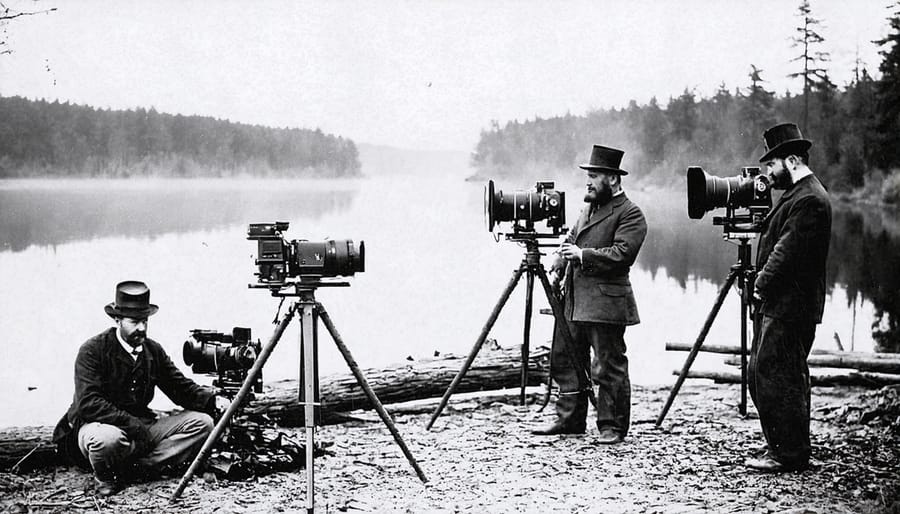
First Nations Influence on Early Park Photography
The relationship between First Nations peoples and early landscape photographers in Ontario was profound yet often overlooked. Indigenous guides played a crucial role in helping photographers discover and access remote locations, sharing their deep understanding of the land’s most photogenic viewpoints and sacred spaces.
Many early photographers learned to see the landscape through an Indigenous lens, incorporating traditional perspectives that viewed nature not as something to be conquered, but as a living entity deserving of respect. This influence can be seen in how photographers began capturing intimate details of the forest floor, medicinal plants, and ancient rock formations – elements that held deep significance in Indigenous culture.
The Algonquin, Ojibwe, and other First Nations peoples helped photographers understand the changing seasons, optimal lighting conditions, and the spiritual significance of specific locations. This knowledge transformed how photographers approached their craft, leading to more thoughtful and culturally aware compositions.
Today, this Indigenous influence continues to inspire photographers to capture Ontario’s landscapes with greater cultural sensitivity and environmental awareness. Many modern photographers work closely with First Nations communities to ensure their work respects sacred sites and tells more complete stories about the land’s heritage. This collaborative approach has enriched our photographic history and continues to shape how we document Ontario’s natural spaces.
The Group of Seven’s Photographic Legacy
From Canvas to Camera
The transition from painted landscapes to artistic landscape photography marks a fascinating chapter in Ontario’s visual heritage. The Group of Seven’s distinctive painting style, with its bold colors and dramatic interpretations of Canadian wilderness, didn’t just influence other painters – it sparked a revolution in how photographers approached nature through their lenses.
In the early 1920s, as the Group gained recognition, photographers began visiting the same locations that inspired these celebrated painters. They discovered that the rugged shores of Georgian Bay, the windswept pines of Algonquin, and the rolling hills of the Canadian Shield offered endless possibilities for photographic composition. Many sought to capture the same raw energy and emotional connection to the landscape that the Group’s paintings conveyed.
This artistic cross-pollination created a uniquely Canadian approach to landscape photography. Photographers experimented with light and shadow, attempting to recreate the dramatic effects seen in works like Tom Thomson’s “The Jack Pine” or Lawren Harris’s stark northern landscapes. They learned to wait for those magical moments when nature mimicked art – when storm clouds gathered dramatically over Lake Superior or when autumn maples blazed with the same intensity as A.Y. Jackson’s canvases.
Today, you can still see this influence in action throughout Ontario’s parks. Modern photographers often frame their shots to emphasize the same elements that captivated the Group of Seven: isolated trees standing proud against vast skies, reflecting lakes that mirror the heavens, and rock formations that seem to pulse with inner life. It’s a wonderful reminder that whether working with brush or camera, artists continue to find inspiration in Ontario’s natural spaces.
For those looking to follow in these creative footsteps, many of the original painting locations are now marked with interpretive plaques, offering perfect starting points for your own photographic exploration. The relationship between canvas and camera continues to evolve, inspiring new generations to see and capture Ontario’s wilderness in their own unique way.
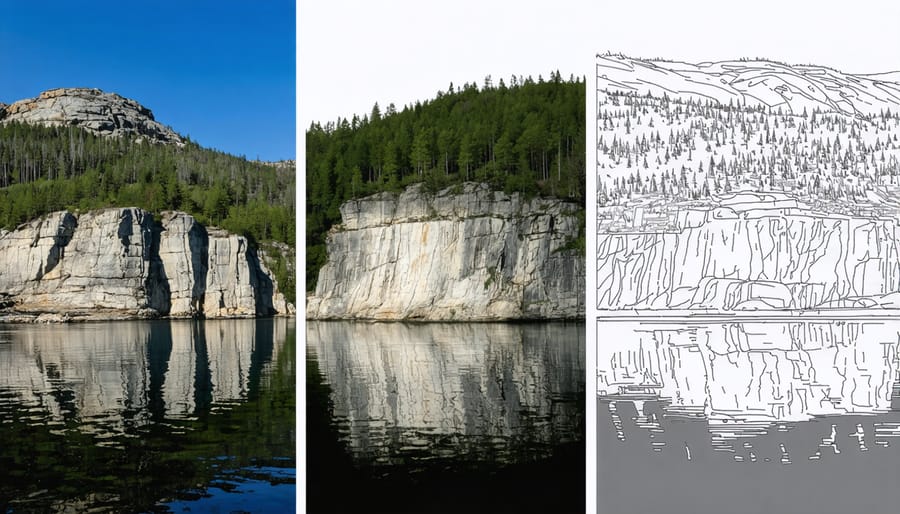
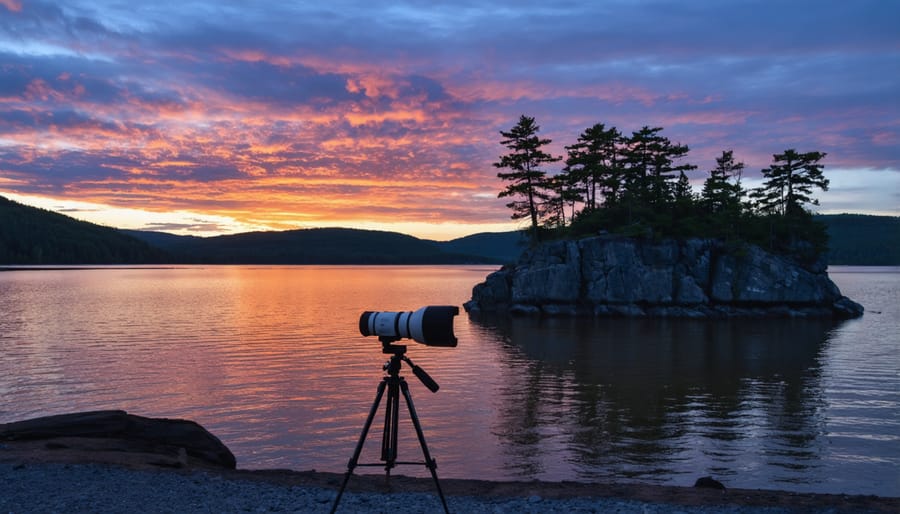
Modern Masters in Ontario’s Parks
Conservation Through the Lens
Today’s landscape photographers do more than capture stunning vistas – they’re powerful advocates for environmental conservation. Through their lenses, they document both the breathtaking beauty of Ontario’s wilderness and the pressing challenges our natural spaces face. Environmental awareness through photography has become a crucial tool in protecting our parks and wild spaces.
Local photographers like Sarah Matthews, who’s been documenting seasonal changes in Algonquin Park for over a decade, help create emotional connections between viewers and landscapes. Her images of endangered wetlands have contributed to successful conservation campaigns and inspired thousands to support park preservation efforts.
Social media has amplified this impact, with Instagram feeds and photography blogs showcasing Ontario’s natural heritage to global audiences. When photographers share their work alongside messages about conservation, they create powerful narratives about protecting these spaces for future generations.
Many park photographers now lead workshops that combine technical skills with environmental education, teaching participants how to capture amazing shots while practicing Leave No Trace principles. These sessions help create a new generation of conservation-minded photographers who understand their role as both artists and environmental stewards.
Through their work, modern landscape photographers continue the legacy of their predecessors while adapting their advocacy for today’s digital age, ensuring Ontario’s wild places remain protected and celebrated.
Today’s park photographers stand on the shoulders of giants, carrying forward a legacy that stretches back to the earliest days of photography. From the pioneering work of those first adventurous spirits who lugged heavy wooden cameras into the wilderness to the instant-sharing capabilities of modern smartphones, landscape photography continues to shape how we see and value our natural spaces.
When you visit Ontario’s parks today with your camera in hand, you’re participating in a tradition that has helped protect these spaces for generations. Those early photographs didn’t just capture views – they sparked a movement that led to the creation of our park system and inspired countless people to explore and preserve our natural heritage.
Whether you’re capturing the golden light at Killarney’s La Cloche Mountains or documenting the changing seasons at Algonquin, you’re helping to tell an ongoing story. Modern park photography plays a vital role in environmental awareness, scientific documentation, and inspiring the next generation of nature enthusiasts.
As you plan your next photography adventure in Ontario’s parks, remember that each click of your shutter adds to this rich historical tapestry. Consider sharing your images on social media with appropriate conservation hashtags, joining local photography groups, or even contributing to citizen science projects. After all, today’s park photographs aren’t just memories – they’re tomorrow’s historical records.
Remember to practice responsible photography: stay on marked trails, respect wildlife, and leave no trace. The future of landscape photography depends on preserving the very landscapes we love to capture.





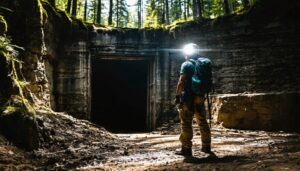
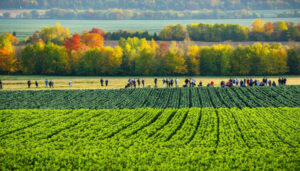

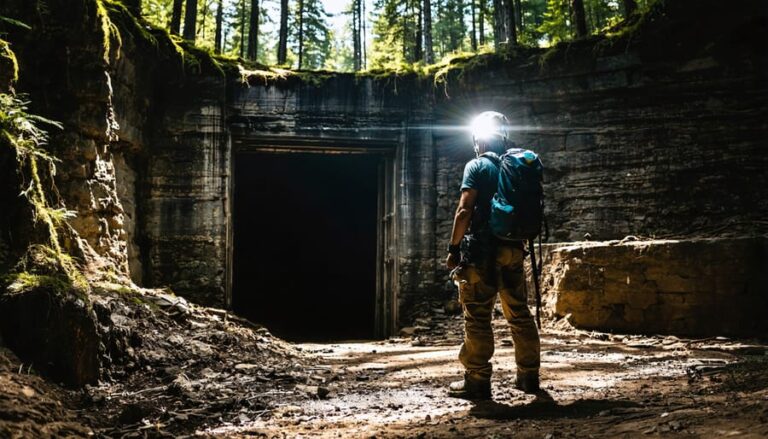
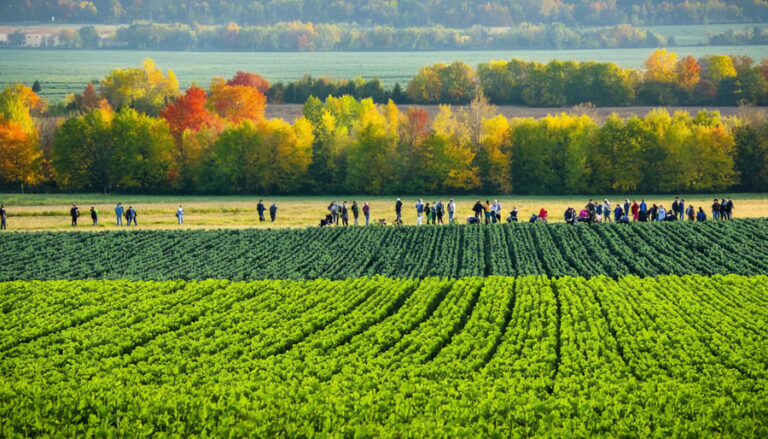




+ There are no comments
Add yours